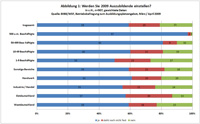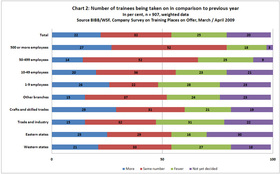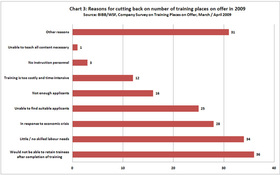Number of training places on offer expected to decline in the coming training year

Werner Friedrich, Klaus Schöngen, Günter Walden
The number of training places on offer is expected to decline this year. This is one of the key findings from a telephone survey of some 1,000 enterprises which the Federal Institute for Vocational Education and Training conducted in cooperation with the Kerpen-based WSF research institute in April 2009. The following report presents further findings from this survey which indicate the major reasons for this decline, the branches of industry and regions in which the decline will be particularly large and whether the number of training places on offer will be large enough to meet the demand from the current school leaver cohort.
Published: June-15-09 URN: urn:nbn:de:0035-0397-9
Companie's recruiting plans
_rdax_280x174s.jpg)
The Board of the Federal Institute for Vocational Education and Training (BIBB) discussed in December 2008 both the current supply of training places and the training place situation expected in the coming year. In light of the already evident financial and economic crisis, concerns were expressed that there could be a sizable drop in the number of in-company training places on offer in autumn 2009. In order to be able to better assess the training place situation, the Board requested the Federal Institute for Vocational Education and Training to ask enterprises about their planned or already implemented trainee acquisition activities for the coming training year.
The Kerpen-based WSF Wirtschafts- und Sozialforschung research institute conducted a computer-assisted telephone interview (CATI) survey of enterprises on behalf of the Federal Institute for Vocational Education and Training in March and April 2009 regarding the training places they would be offering in the coming 2009/2010 training year. A total of 4,779 firms were contacted, 1,971 of whom had provided in-house vocational training during the last five years. A total of 907 enterprises had trainees in 2008 and/or planned to take on trainees in 2009. Extensive interviews on the development of the training place situation were conducted with these 907 firms which are currently providing in-company vocational training or have done so in the last five years. Nine out of ten surveyed enterprises were providing in-company vocational training at the time the survey was conducted.
The findings presented in this report refer to this group of enterprises. The findings were weighted on the basis of the trainee numbers in the 2007 Betriebs- und Beschäftigtenstatistik enterprise and workforce statistics issued by the Federal Employment Agency and using information on vocational training contained in the BIBB Data Report for the Report on Vocational Education and Training for the Year 2009. Thus, the weighting was not based on the enterprise and employee concept but rather on the 'training place concept'. This means that each enterprise received the weight that corresponds to its importance for the total number of training places on offer. This weighting was undertaken
- on the basis of four company size classes,
- for six branches of industry (manufacturing, construction, trade, services, public administration and education, miscellaneous),
- according to the company's location in either the western states or eastern states and
- according to training sector: trade and industry, skilled crafts and trades, and miscellaneous relevant bodies.
In order to ascertain the number of training places that will be offered in the future, participating enterprises were asked whether they would offer training places in 2009 and if so, how many they would be offering. In the event that they were not certain, they were asked to provide an estimate. The probable number of training places that will be offered in 2009 was calculated using the full value of the figures provided in the definite answers and two-thirds of the value of the estimates.
Enterprises' willingness to provide in-company vocational training

ome six out of ten enterprises surveyed plan to take on trainees in the coming training year. One out of every five was still undecided (see Chart 1). A particularly large number of firms in eastern Germany had not yet made a final decision.
Twenty-two per cent of the companies surveyed said they planned to increase the number of training places they offer in the coming training year. Thirty-two per cent indicated they wanted to offer the same number as in the previous year (see Chart 2). By contrast, 25 per cent of the firms surveyed said they planned to offer fewer training places than in the previous year and another 20 per cent could not provide a definite answer. This indicates that the share of enterprises that want to reduce the number of training places they offer is larger than the share of enterprises that want to offer more training places. This tendency is greater among enterprises in trade and industry, with only 15 per cent wanting to increase the number of training places they offer, while twice as many (31%) want to cut back. In contrast, the estimates were quite different among craft enterprises. Only 21 per cent of these enterprises plan to reduce the number of training places they offer, whereas 20 per cent want to increase the number. A comparison of Germany's eastern states and western states shows that it is primarily enterprises in the western half of the country that plan to reduce the number of training places they offer for the 2009/2010 training year.

The effects of the current economic crisis are evident in the reasons cited for cutting back on the number of training places on offer compared to the previous year. Nearly one out of every three enterprises (28%) directly cited economic difficulties as the reason for reducing the number of trainees it would be taking on. The two most frequently quoted reasons - "it will not be possible to retain trainees after completion of their training" (36%) and "no demand for skilled workers" (34%) - are also to be seen in this context (Chart 3).

The majority of enterprises that want to offer the same number of training places as in the previous year or raise it views an increase in their training activities as an opportunity to fill vacancies better, as a cost-effective alternative to recruiting skilled workers and as a means to ensure a balanced age distribution in their workforces. They also frequently cite company tradition and social responsibility as reasons for providing vocational training.
Number of training places on offer in 2009
_rdax_280x167s.jpg)
The extrapolation for the number of training places that are expected to be offered for the coming 2009/2010 training year was broken down for the individual cells (six branches of economic activity X four company size classes). These figures add up to 566,000 new training contracts as the most likely quantity. Thus, the number of new training contracts will probably decline by some 50,000 (-8%) over the prior training year (616,000 new training contracts). The previous forecast calculated by BIBB on the basis of an econometric model (new training contracts + vacant training places) indicated a range from 580,000 to 600,000 training places (for more on the method used here, please see the BIBB Data Report for the Report on Vocational Education and Training for the Year 2009, pp. 67-69). Although the BIBB Company Survey on Training Places on Office was extrapolated on the basis of the number of new training contracts, and the number of vacant training places (2008: 19,500) have to be added to this figure, both methods come to largely similar results. The survey conducted by the Association of German Chambers of Industry and Commerce (DIHK) also predicts a comparable decline (5% to 10%) (source: DIHK, Vocational Training 2009 - Findings from an Online Company Survey).
This decline can be particularly observed in trade and industry where a decrease of some ten per cent is to be expected (Chart 5). In contrast, the number of in-company vocational training places offered in the crafts and skilled trades will remain close to the previous year's level (-1%). The decline will be greater in the western states (-9%) than in the eastern states (-4%). The number of training places offered by large companies with more than 500 employees will stay more or less at the level seen in the previous year (-1%). The decline will be especially noticeable among small and medium-sized enterprises in trade and industry.
Taking potential demand into account (based on the narrower definition: school leavers from general and vocational schools plus unplaced training place applicants from previous years), the Federal Institute for Vocational Education and Training calculated target figures that would ensure that the training opportunities available to youths and young adults remain at the level seen in 2008 (see BIBB, Data Report for the Report on Vocational Education and Training for the Year 2009, p. 64 ff.). A total of 604,000 training places would have to be offered nationwide in order to reach a ratio between supply and demand on the training place market similar to that seen in 2008. According to the forecast from the BIBB Company Survey on Training Places on Offer, the supply of training places will fall some 18,000 short of this goal.
Enterprises' training plans for the next three years

The enterprises surveyed were reserved regarding the number of in-company training places they would be offering in the next three years (see Chart 6). Three out of every four firms expect to stay at the same level, while six per cent want to increase the number and another six per cent plans to cut back. One out of every six enterprises plans not to take on any trainees during the next three years.
The number of in-company training places offered in Germany's western states will probably stagnate during the next three years. Six per cent of the enterprises surveyed said that they expect the number to fall; another six per cent expect an increase. The number of training places offered in the eastern states is likely to increase slightly because 14 per cent of the enterprises plan to add training places and only seven per cent plan to cut back. The pressure arising from the shortage of skilled labour that is already evident in the eastern half of the country could also be a factor in these companies' decision to take on more trainees.
Large companies are also being guided by similar considerations when planning the number of vocational training places they will be offering in the future. Fourteen per cent of the large companies surveyed said they plan to increase the number they offer while only eight per cent reported that they intend to reduce the number. A slight decline is to be expected among small and medium-sized enterprises.
A break-down by branch of economic activity shows that the number of in-company vocational training places on offer will remain stable and perhaps even increase in the coming three years. This particularly applies to the service sector. The trend in the trade sector will tend towards a decline.
Eight per cent of the enterprises in the trade and industry training sector plan to reduce the number of training places they offer. Ten per cent intend to add training places. Any changes in the crafts and skilled trades are also expected to remain small. However, the share of enterprises in the crafts and skilled trades that plan to increase the number of training places they offer (6%) is larger than the share that says it plans to cut back (3%).
A break-down between industrial/technical and commercial occupations that require completion of formal vocational training ('training occupations') reveals more likelihood of a slight decline in the number of training places in the industrial/technical category. There will probably be little change among commercial and service occupations. It must be noted however that the findings from this survey lack certainty. Many firms were unable to provide definitive statements regarding whether they would be adding or cutting back on training places (industrial/technical occupations: 27%; commercial and service occupations: 37%).
The impact that the assessment of the current economic situation has on the number of training places being offered
_rdax_280x176s.jpg)
A distinct connection can be seen between the number of training places an enterprise anticipates offering in 2009 and the respective company's current economic situation.
Chart 7: Change in the number of training places that will be offered in 2009
Enterprises that are in a good economic situation exhibit two attributes in particular: Firstly, a large share of such companies (55%) want to take on the same number as or more trainees than in the previous year. Secondly, the vast majority of these firms is in a position to provide concrete information on their plans for the coming training year.
In contrast, firms that cited their medium-term economic outlook were noticeably more reserved about quantifying their plans to take on trainees. One out of every four enterprises could not make a conclusive statement. On balance, the majority of firms plans to offer fewer training places in autumn 2009 constitute the majority.
Nearly half of the enterprises that find themselves in a bad economic situation plan to cut back on the number of training places they offer. One out of every five said that they had not yet decided on the number of places they would be offering in the coming training year.
Many enterprises are still uncertain about the effects that the financial / economic crisis will have. Accordingly, their plans for the coming training year are marked by uncertainty. Their efforts to maintain the number of training places they offer at a high level and not allow this number to be affected by passing difficulties in their business situation are quite evident. However, it cannot be ruled out that the economic crisis might worsen and many enterprises have not yet felt its full effect. For this reason, the prediction that BIBB makes here constitutes only an interim finding and is subject to the economy not deteriorating any further than could be foreseen to date.
The projected gap - a shortfall of some 18,000 training places that would be needed in 2009 to replicate the previous year's training place situation - is small enough that it could be closed with the help of existing programmes. In the survey, many enterprises indicated their efforts to maintain the number of in-house vocational training places they provide. Chambers, associations and employment agencies are called upon to conduct suitable information and publicity campaigns to foster the creation of additional in-company vocational training places. Existing support instruments (such as the training bonus for unplaced applicants from previous years) should be put to greater use. The civil service sector (federal government, state governments, municipal governments) is called upon to provide training places in order to stabilize the situation on the training place market. However, it will be important not only to convince enterprises to create new in-company training places. In light of the current economic crisis, additional action will be needed as a result of the growing number of 'bankruptcy apprentices' who have lost or will lose their training place because the company providing their in-house vocational training has gone bankrupt.
Date of publication, information Deutsche Nationalbibliothek
Publication on the Internet: June-15-09
This online publication has been registered and archived with the German National Library.
URN: urn:nbn:de:0035-0397-9
Creative Commons-Lizenz

Content on this page is licensed under the Creative Commons License "Attribution: Noncommercial-No Derivative Works 3.0 Germany". Further information on this is available on our Creative Commons page (de).